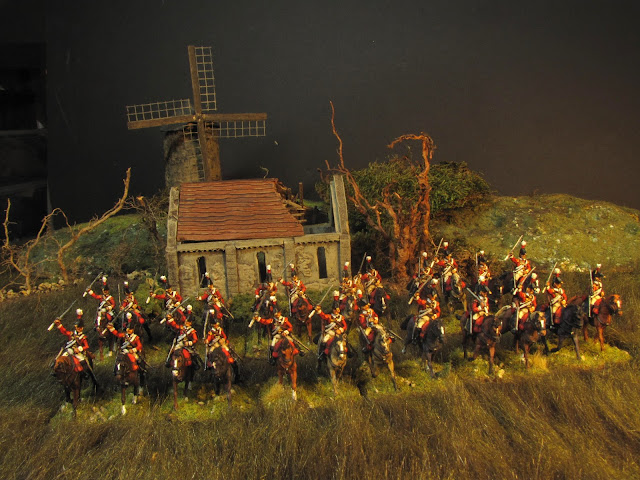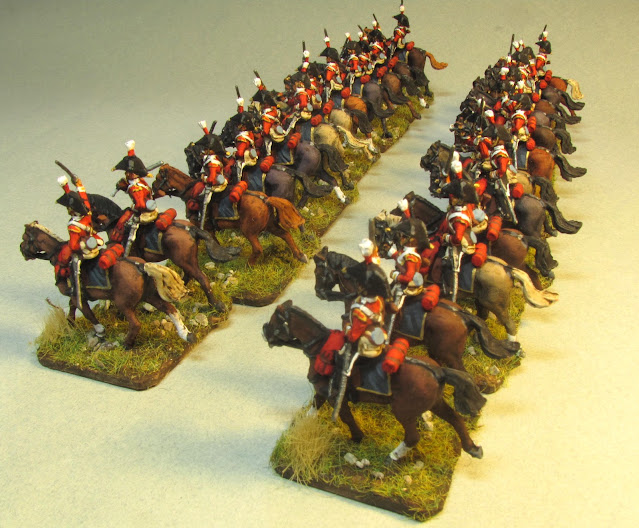It has been a while since I have posted much in the way of painted figures, but have every intention to catch up on that over the next while. With the completion of my 3rd Dragoon Guards I now have, in conjunction with the 4th Dragoons, the British heavies I need for Talavera.
Once again these are the less than perfect HaT set, requiring a lot of fussy pinning and plume adding, but I still find that their beautiful red coats paint up very nicely and look just fine en masse.
A bit of History
First established as the Earl of Plymouth's Regiment of Horse in 1685, this venerable unit was renamed the 3rd Regiment of Dragoon Guards in 1751, receiving the Prince of Wales (future George IV) designation in 1765.
The 3rd Guard's Peninsular record is less than brilliant. They were brigaded with the 4th Dragoons (Queen's Own) and landed in Portugal in late April 1809 at the beginning of Wellesley's Oporto campaign under the command of Major General Henry Fane, although they took no direct part in the expulsion of the French from Portugal. It is only when the allied army marches into Spain that the heavies become more actively involved, although even at Talavera they see little if no action in support of Anson's Brigade where the the ill-fated 23rd plunged head long into an unknown dry watercourse.
Their command passes to Major General George de Grey, spending the next two years in relative inactivity, joining Hill's southern army (under command of Beresford as Hill was laid low by malaria) for the Battle of Albuera in May 1811. A reorganization early in 1812 sees them moved to the northern 1st Division Cavalry where they are now brigaded with the the 1st Dragoons and rejoined by the 4th, brought forward from the back area where they had been since August 1811. They are once again in action at the Combat at Maguilla, against a force of French dragoons commanded by Lallemand, where the British cavalry's famously inept leadership (at this point the brigade was commanded by Slade) successfully turned a victory into a defeat through an uncontrolled and chaotic pursuit of the enemy.
Following Maguilla they once again went into a period of relative inactivity, joining Wellesley's army as it marched north into Spain and eventually France in 1813-14, but seeing little if any action before finally returning to England on the 20th of July, 1814 after peace is declared. They were not present at Waterloo.
For more information on their history in the Peninsula: https://www.napoleon-series.org/military-info/organization/Britain/Cavalry/WellingtonsCavalry/c_3rdDragoonGuards.html
Here are a few pictures of the completed unit (two units really, six stands apiece, which accounts for the two command stands with trumpeters). I couldn't find any definitive reference for the saddle blanket (a few post Napoleonic images only) so went with a nice royal blue with gold trim.










Nice work on these Bill. I have two stands of HaT Light Dragoons....they were supposed to be the hard plastic 28mm version but despite the correct codes on the boxes etc, they were actually the rubbery 1/72 version, and luckily, the retailer I got them off, accepted the rest back. It was a shame really, if I could have found a source of genuine 28mm hard plastic cavalry for half the price of Perry, and available locally in NZ, I probably would have tripled the size of my current British cavalry force! Ah well, it was not to be......
ReplyDeleteYes, the set was a huge disappointment on so man levels. The delay of delivery when it was crowd-funded, diminutive cavalry sabres, different sized figures within a set, missing plumes, bad fits on pieces, poor casting. But 1/72 soft plastic when they were supposed to be 1/28 hard plastic? Crazy...
DeleteVery nicely painted unit.
ReplyDeleteThank you!
Delete